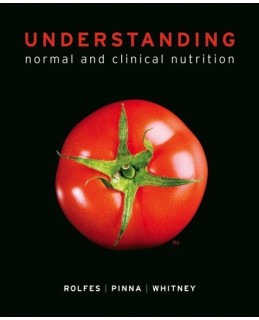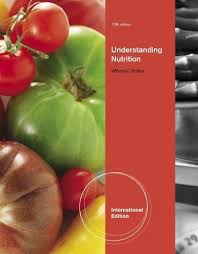Description
Understanding Normal and Clinical Nutrition 9th Edition By Sharon Rady Rolfes – Test Bank
Table of content
1. AN OVERVIEW OF NUTRITION.
2. PLANNING A HEALTHY DIET.
3. DIGESTION, ABSORPTION, AND TRANSPORT.
4. THE CARBOHYDRATES: SUGARS, STARCHES, AND FIBERS.
5. THE LIPIDS: TRIGLYCERIDES, PHOSPHOLIPIDS, AND STEROLS.
6. PROTEIN: AMINO ACIDS.
7. METABOLISM: TRANSFORMATIONS AND INTERACTIONS.
8. ENERGY BALANCE AND BODY COMPOSITION.
9. WEIGHT MANAGEMENT: OVERWEIGHT, OBESITY, AND UNDERWEIGHT.
10. THE WATER-SOLUBLE VITAMINS: B VITAMINS AND VITAMIN C.
11. THE FAT-SOLUBLE VITAMINS: A, D, E, AND K.
12. WATER AND THE MAJOR MINERALS.
13. THE TRACE MINERALS.
14. LIFE CYCLE NUTRITION: PREGNANCY AND LACTATION.
15. LIFE CYCLE NUTRITION: INFANCY, CHILDHOOD, AND ADOLESCENCE.
16. LIFE CYCLE NUTRITION: ADULTHOOD AND THE LATER YEARS.
17. NUTRITION CARE AND ASSESSMENT.
18. NUTRITION INTERVENTION.
19. MEDICATIONS, HERBAL PRODUCTS, AND DIET-DRUG INTERACTIONS.
20. ENTERAL NUTRITION SUPPORT.
21. PARENTERAL NUTRITION SUPPORT.
22. METABOLIC AND RESPIRATORY STRESS.
23. UPPER GASTROINTESTINAL DISORDERS.
24. LOWER GASTROINTESTINAL DISORDERS.
25. LIVER DISEASE AND GALLSTONES.
26. DIABETES MELLITUS.
27. CARDIOVASCULAR DISEASE.
28. RENAL DISEASES.
29. CANCER AND HIV INFECTION. Appendices.
Chapter 2 – Planning a Healthy Diet
An. Page(s)/difficulty K = knowledge-level, A = application level
Multiple Choice
Questions for Section 2.1 Principles and Guidelines
b 35(K) 01. The diet-planning principle that provides all the nutrients, fiber, and energy in amounts sufficient to maintain health is called
a.variety.
b.adequacy.
c.moderation.
d.kcalorie control.
d 35(K) 02. What are the principles of diet planning?
a.Abundance, B vitamins, kcalories, diet control, minerals, and variety
b.Abundance, balance, conservative, diversity, moderation, and vitamins
c.Adequacy, bone development, correction, vitamin density, master, and variety
d.Adequacy, balance, kcalorie control, nutrient density, moderation, and variety
b 36(A) 03. Which of the following is the most calcium-dense food?
a.Whole milk
b.Nonfat milk
c.Low-fat milk
d.Cheddar cheese
c 36(K) 04. Nutrient dense refers to foods that
a.carry the USDA nutrition labeling.
b.are higher in weight relative to volume.
c.provide more nutrients relative to kcalories.
d.contain a mixture of carbohydrate, fat, and protein.
d 36(K) 05. The concept of nutrient density is most helpful in achieving what principle of diet planning?
a.Variety
b.Balance
c.Moderation
d.kCalorie control
a 36(A) 06. Which of the following is an expression of the nutrient density of a food?
a.0.01 mg iron per kcalorie
b.110 kcalories per cup
c.0.5 mg iron per serving
d.110 kcalories per serving
d 36(A) 07. An empty-kcalorie food is one that contains
a.no kcalories.
b.an abundance of vitamins but little or no minerals.
c.an abundance of minerals but little or no vitamins.
d.energy and little or no protein, vitamins or minerals.
c 36-37(K) 08. Providing enough, but not an excess, of a food is a diet-planning principle known as
a.safety.
b.variety.
c.moderation.
d.undernutrition.
d 37(A) 09. Applying the principle of variety in food planning ensures the benefits of
a.moderation.
b.vegetarianism.
c.nutrient density.
d.dilution of harmful substances.
c 38(A) 10. Which of the following practices is not consistent with achieving a healthy diet?
a.Intake of eggs
b.Intake of nuts
c.Emphasis on trans-fat
d.Emphasis on low-fat milk products
d 38-39(K) 11. Which of the following is among the recommendations of the Dietary Guidelines for Americans?
a.Practice good foot hygiene
b.Reduce complex carbohydrate intake
c.Reduce monounsaturated fat intake
d.Engage in regular physical activities
Questions for Section 2.2 Diet-Planning Guides
d 42(K) 12. The consumption of 1900 kcalories per day is appropriate for most
a.teenage girls.
b.children.
c.sedentary men.
d.sedentary women.
c 39(K) 13. Which of the following is not a feature of a food group plan?
a.Defines serving equivalents
b.Considered a tool for diet planning
c.Sorts foods of similar water content
d.Specifies the number of servings from each group
b 39-41(A) 14. Consider the following menu from the point of view of the USDA Food Guide.
|
Breakfast |
Lunch |
Supper |
|
2 eggs 1 tsp margarine 2 slices enriched white bread 1 c whole milk coffee |
2 oz tuna fish lettuce 1 tbsp mayonnaise 2 slices enriched white bread 1 apple |
3 oz hamburger meat 1 oz cheese ½ c cooked rice ½ c carrots coffee |
Which of the following describes the nutritional value of the fruits and vegetables in this menu?
a.A source of vitamin A is missing
b.A source of vitamin C is marginal
c.The daily amounts recommended for a 2000-kcalorie diet are met
d.The daily amounts recommended for a 2000-kcalorie diet are exceeded
c 39-42(A) 15. Jamie is a vegetarian who is trying to plan a healthy diet according to the USDA Food Guide. Which of the following meat alternatives would be the best nutrient choices for one day?
a.2 pieces bacon, ½ can tuna, 2 pieces bread
b.3 oz. cheese, ½ sweet potato, 2 tbsp peanut butter
c.½ cup black beans, 2 tbsp peanut butter, 1 c spinach
d.1 skinless chicken breast, 2 egg whites, meal replacement bar
d 40(K) 16. Of the daily recommended intake of fruit servings, what maximum percentage may be supplied by fruit juice?
a.10
b.20
c.33
d.50
b 40(K) 17. What two major nutrients are supplied by the fruit and vegetable groups?
a.Vitamins D and E
b.Vitamins A and C
c.Protein and calcium
d.B vitamins and iron
b 40;41(A) 18. Which of the following is not characteristic of the USDA Food Guide?
a.It places most foods into one of five groups
b.Its nutrients of greatest concern include iron, chromium, and vitamin B12
c.It can be used with great flexibility once its intent is understood
d.It specifies that a certain quantity of food be consumed from each group, based upon energy intake
d 40;52(K) 19. All of the following are examples of legumes except
a.peas.
b.beans.
c.peanuts.
d.potatoes.
a 41(A) 20. Which of the following is a meat alternative in the protein foods group?
a.Nuts
b.Bacon
c.Baked potatoes
d.Sweet potatoes
a 40(K) 21. In which of the following food groups are legumes found?
a.Vegetables
b.Dairy
c.Fruits
d.Grains
b 42(A) 22. Which of the following foods could help meet the iron needs of vegetarians who consume dairy?
a.Coconut
b.Legumes
c.Skim milk
d.Potato salad
c 42(K) 23. How many subgroups comprise the vegetable food group?
a.1
b.3
c.5
d.7
b 43,52(K) 24. Legumes are used as meat alternatives for all of the following reasons except
a.they are economical.
b.they can be graded as prime, choice, and select.
c.they can be processed to look and taste like meat.
d.they contribute the same key nutrients, including zinc and protein.





Be the first to review “Understanding Normal and Clinical Nutrition 9th Edition By Sharon Rady Rolfes – Test Bank”